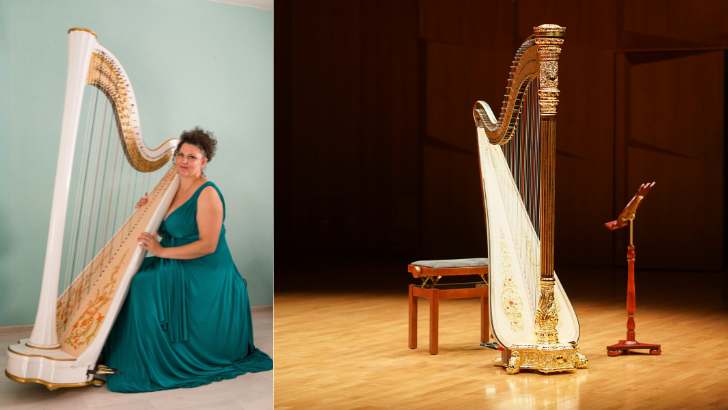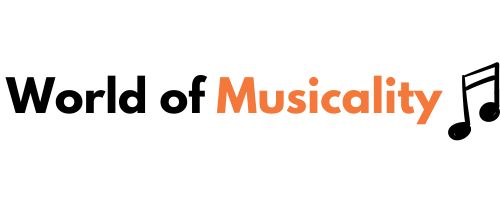
The pedal harp, also known as the concert harp, is a large and complex instrument used in classical music and orchestras.
It features a mechanism operated by pedals to change the pitch of the strings, allowing for a wide range of musical expression.
Instrument Description
| Instrument Name | Pedal Harp (Concert Harp) |
| Instrument Family | String |
| Alternative Names | The pedal harp is also referred to as the “concert harp” or “orchestral harp.” These names emphasize its prevalent use in concert settings and orchestras. |
| Geographical Presence | The pedal harp is played worldwide, particularly in Europe, North America, and Asia. It is a staple in classical orchestras and also features prominently in solo and chamber music performances. |
| Instrument Classification | The pedal harp falls under the Hornbostel-Sachs classification system as 322.222, identifying it as a plucked chordophone with strings that can be altered by pedals. |
| Unique Features | The pedal harp is known for its intricate pedal mechanism, which allows the harpist to change the pitch of the strings by pressing one of the seven pedals. This feature enables the harpist to play a full chromatic scale and switch keys seamlessly. The harp also has a large, resonant soundbox that contributes to its rich tone. |
| Sound Characteristics | The pedal harp produces a rich, full sound with a wide dynamic range. It can create delicate, soft tones as well as powerful, resonant sounds. The ability to change pitches quickly with the pedals allows for a versatile expression of music. |
| Typical Music Genres | The pedal harp is primarily used in classical music, including solo pieces, chamber music, and orchestral works. It is also used in contemporary music, film scores, and occasionally in jazz and popular music. |
| Components | Soundboard, Pillar, Neck, Strings, Tuning Pins, Pedals |
| Construction | The pedal harp is typically made of high-quality woods such as maple and spruce. It features a large, curved neck, a vertical pillar, and a wide, resonant soundboard. The strings are made of gut, nylon, or wire, and the pedal mechanism is crafted from metal and wood. |
| Size and Weight | The pedal harp stands about 1.8 meters (6 feet) tall and weighs between 32 to 40 kilograms (70 to 90 pounds). Its size and weight contribute to its rich sound and powerful presence on stage. |
| Variations and Customizations | Variations of the pedal harp include different sizes and designs, such as the single-action and double-action harps. Customizations might include decorative carvings, inlays, and finishes, as well as the choice of materials for the strings and soundboard. |
| Instrument History | The pedal harp evolved from earlier harps in the 18th century when harp makers began adding pedal mechanisms to change the pitch of the strings. This innovation allowed for greater musical flexibility and led to the development of the modern concert harp. The double-action pedal harp, which can raise each string by two half-steps, was perfected by Sébastien Érard in the early 19th century and remains the standard in classical music. |
| Similar Types of Harp | Celtic Harp, Lever Harp, Paraguayan Harp |
| Playing Technique | The harpist plucks the strings with their fingers, using both hands to create melodies, harmonies, and arpeggios. The pedals are used to change the pitch of individual strings, allowing for chromatic notes and key changes. Proper hand positioning and finger techniques are essential for producing a clear and resonant sound. |
| Notable Composers | Claude Debussy, Maurice Ravel, Carlos Salzedo |
| Famous Works | Debussy’s “Danses sacrée et profane,” Ravel’s “Introduction and Allegro,” Salzedo’s “Scintillation” |
| Maintenance | Regular maintenance includes tuning the strings, adjusting the pedals, and occasional string replacement. The wooden body should be kept clean and occasionally polished. Proper storage in a controlled environment is important to prevent damage from humidity and temperature changes. The pedal mechanism also requires periodic servicing by a professional technician. |
| Learning Difficulty | High; mastering the pedal harp requires extensive training to coordinate hand and foot movements. Learning proper hand techniques, pedal techniques, and music theory is crucial for effective playing. |
| Prominent Players | Alice Giles, Yolanda Kondonassis, Emmanuel Ceysson |
| Notable Performances | Notable performances include solo recitals, orchestral concerts with major symphonies, and appearances at international harp festivals. |
| Famous Orchestras/Bands | Prominent ensembles featuring the pedal harp include the Berlin Philharmonic, the New York Philharmonic, and the London Symphony Orchestra. |
| Price Range | Pedal harps range from $15,000 to $50,000 or more, depending on the size, materials, and craftsmanship. Beginner models start around $15,000, while professional models with custom features can exceed $50,000. |
| Interesting Facts | 1. The pedal harp can have up to 47 strings, making it one of the largest and most complex string instruments. 2. The double-action pedal harp, invented by Sébastien Érard, revolutionized harp playing by allowing for greater musical versatility. 3. The harp has been used in orchestras since the early 19th century and is featured in many classical masterpieces. 4. Harpists use a special technique called “glissando” to create sweeping, cascading sounds by running their fingers across the strings. 5. The pedal harp’s extensive range and expressive capabilities make it a favorite among composers for both solo and ensemble works. |
If you would like to learn more facts about the amazing world of musical instruments, visit our homepage at worldofmusiclality.com or click the links below to explore the rest of our site.







